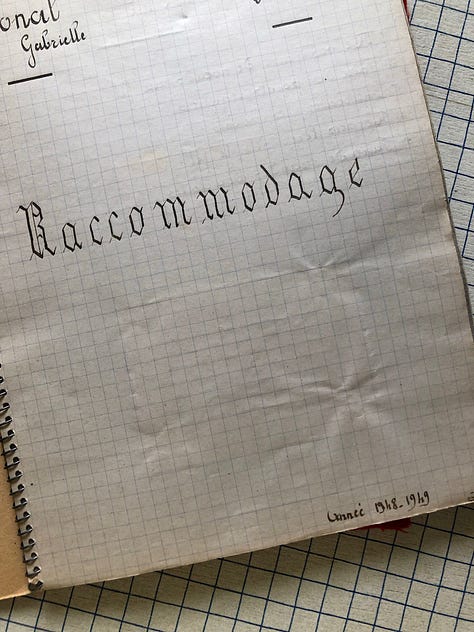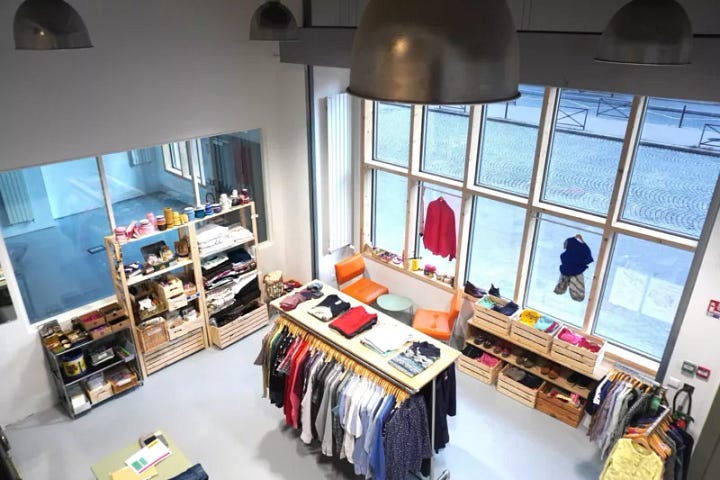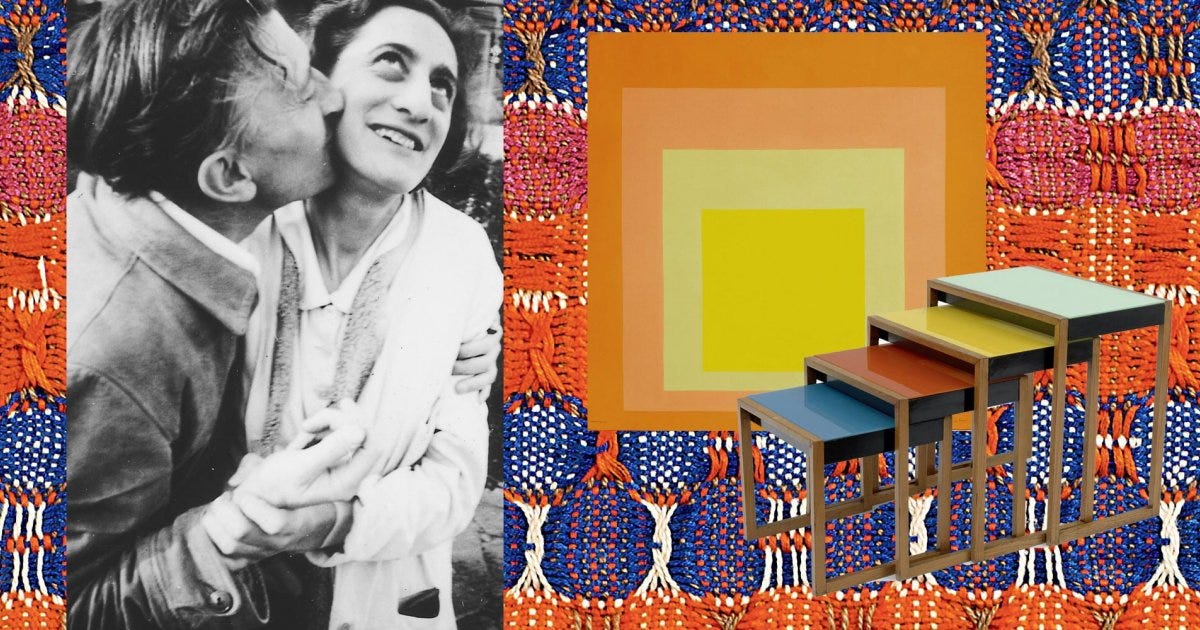#086 ✰ My Tailor is My Friend: Clara Metayer
Parisian tailor - founder of Sauve Qui Peut! - Patine tailor in residence
7am. You get out of the shower. You grab that pair of jeans you love from your closet. Hole under the butt. Not crazy big… but yeah no, forget about it. The fabric no longer holds together. Et voilà. Bummer. What should you do now? Repair it? No time for this, plus you can’t even recall how to turn on your sewing machine ; Cut it into rags? What a waste, it’s not that big of a hole ; Throw it away - but where? Chance is you’ll slide it back at the bottom of the pile, or - if you’re slightly more organized - on top of a “need to fix” stack of clothes. That will remain here, motionless, forever.
I heard about Sauve Qui Peut ! a couple months ago, when the above story happened to me and my Patine jeans. Clara is the tailor in residence in their boutique, among many other activities, and I have been following her mending craft since. She does visible or invisible miracles out of holes in any fabrics.






“Sauve qui peut!” is a French expression that means “Run for your life!”. Also, this pun literally translates as Saves-Who-Can, which probably fits Clara’s craft better. Without further ado, please meet Clara!



So Clara, what is your craft about?
My work is all about mending. The idea being “you own a garment, you like it, you want to keep it, you’re not buying a new one”. I split my time across five activities: mending services, sewing classes, creative repair, enterprise events and tailor-in-residence.
🪡 mending services
This is where I started. People reach out (email, DM). We agree to meet in person, for 5-10 minutes at La Textilerie - a creative place in Paris dedicated to re-enchanting textiles. That’s when they handover their garments to me. Any kind of garment. Any kind of repair. Visible or invisible mending.
This is quite a slow process from the time I receive the email to the time I deliver the repaired garment to my customer. I stand by that. Also, there’s a lot of my time involved. This has to reflect in the overall price I charge my customers. This wasn’t obvious when I started but now I get paid at my fair value.
From what I see, price isn’t really an issue. When you love your cashmere sweater, you might spend 100€ to have it repaired. Whenever you can of course. Recently, a lady brought me a bunch of cardigans for a total mending worth 700€.
Mending garments made me meet a lot of people, and I started to realise two things:
quite a number of them where reaching out for very basic needs - like replacing a button, fixing a little hole or undone stitches
others didn’t necessarily had the budget to repair all their worn out clothes : when you’re a young mother you might not pay 30€ per mending if you have dozens of kids’ clothes to repair
That’s how I started to give classes.
✂️ sewing classes
→ Learn how to do it by yourself.
I teach mending every Monday evening and one Sunday a month, at La Textilerie.
My customers? People in their thirties, mainly young mums, largely feminine still (dudes, where are you?!). I also have newly retired people who want to get back to mending.
The most popular class is a 3-hour workshop called the essentials of hand sewing for mending. I teach the basics : the tools, how to thread a needle, do a resistant hand stitching and invisible hems, fix buttons, stitch undone stitches and repair a little snag
There’s another 3-hour class focused on repairing holes by hand: hessian stitch mending, that basically imitates the weaving of fabrics and the circular mending, visible, or invisible, as you can see:



Finally, I teach a class to help you repair your favorite jeans (with a sewing machine this time):


🧵 creative repair
This is where I transform a worn out piece -from the flea market or from your closet- in a creative way. I love when people trust me with this process ; look this is what happened with a worn out shirt:


🎉 enterprise events and team-building
These usually happen over lunch, they are an hour long, to learn the basics. I like this format where I am the one bringing mending to people. Participants join voluntarily. People often give me that look “I already know how to repair” which is quite stressful at times, but it’s always great to see them pick up new techniques and be excited about it.
👖 tailor in residence at Patine Studio
I go to the boutique once to twice a month. They’ve set up a ‘repair zone’ in the back. At their opening party, I came to see Charlotte, the founder ; it went something like:
Clara: how’s this repair thing working exactly?
Charlotte: yeah, we’re looking for someone
Clara: I do repair!
… and this is how we kicked this off!
I repair jeans: invisible mending on holes, exclusively. They estimate for how long they need me, then I go work from there. I like changing set ups, interacting with customers, see their intrigued look!


I wouldn’t do that with any brand - some reached out a couple times - but I’ve known Patine since their beginnings and really like their philosophy.
(…)
Save the date, friends ⚡️July 25th ⚡️
San Francisco people, let’s meet!
Bring a piece of denim you love and get ready for some good time 🥂
(…)
How did it all start? Tell me the full story.
Grandma
Early on, I wanted to sew and use this skill to rehabilitate fabrics and garments. I wanted to create new pieces from existing fabrics. My grandma learnt mending at school when she was a kid (girls would learn “racommodage”, boys DIY) and passed me her notebook, a true gold mine of techniques.



Over time, I realised that I didn’t want to sell new products. We already have so much. How about keeping those we have and love? This opened a brand new world! Mending is made of so many techniques. For one given challenge, there are a thousands solutions: visible -embroidery, patches,…-, invisible - darning, or the art of recreating fabric literally, be it jeans or wool stitches,…
Textile related events
I studied communication and started working part time for a company selling sewing templates. I already knew a few basics, and their pattern maker taught me a lot. Around the same time I was also organising events for La Textilerie. Until then I was mainly self-taught.


Then I took evening sewing class with the City of Paris (it used to be for hobbies, now you need a real career change project to enrol), where I learnt mainly alteration (change of shape).
The haha moment
Every day at La Textilerie, people would come and drop large bags of garments that they wanted to get rid of. Inside, there was always beautiful, vintage pieces that had a little hole or a missing button, and this is why people didn’t want them anymore. I was like “why don’t they mend these?” “why don’t we mend these at La Textilerie?” (we didn’t do anything with these pieces at the time - they do now). Our generation never got to learn the art of mending, so it’s not instinctive. And even if we wanted to, we lack the skills. This made me sad. Listen, a lady came once with trash bags full of Hermès sweaters, telling me “these were moth-eaten, I can’t do anything”. We did not either. What happened to these pieces? They were probably incinerated. I still think about them.
More qualification
I decided to enrol as an independent candidate for a “CAP Couture”(sewing professional qualification). Ironically, they don’t teach mending at all. What they teach is how to assemble a garment together, the industrial way. What this means is that there’s a range of assemblies that you must follow to have your garment sewn to the nearest millimeter without defects, according to industry codes. I am glad I got this diploma though, it attests a certain experience.
Mending it is!
I started taking piles of worn out garments from La Textilerie, upon which I did visible mending, and sold them at La Textilerie. I wanted to see how people would react over visibly repaired garments. Turns out it worked pretty well! Oftentimes, when repair is visible, it embellishes the garment and this ads value to it.
What do you like most in what you do?
I love working with wool, I love darning wool.
I love the material, it is alive. I admire the work that’s done from taking care of the sheeps to shaving them, from cleaning the wool to weaving it - I am talking about the old ways of doing so - And then the knitting! Deep down, it comes down to me watching my grand mother knit. She is now 103. She taught me how to knit when I was a kid. I still wear pieces today that she knitted - for my mum - a while ago. Can you imagine: she kept track of every single garment she knitted in her life. She passed me these notebooks along - there were a lot of them.
I love that every single piece is a new challenge depending on the stitches style. I learnt the techniques with a lady who generously teaches darning in Paris.
What are your challenges today?
I think I am done working alone in my atelier. There are days when it’s tough to keep your motivation high. I am training somebody to help me do the mending projects I have already done many many times. I am also thinking of setting up in a shared spot for creatives, to leverage on a collective momentum. As long as there’s a challenge, I love it.
Financially, it is tough. I didn’t choose this craft to get rich but I won’t deny money is important. It has helped me rewire the relationship I had with money. You start thinking twice about buying that 20€-homemade-ice-cream-jar [laughs]. I learnt how to live more simply, buy less.
How do you dress?
I really love vintage clothes. I do think it was better before [laughs], look at this quality of fabrics [thick jeans], you won’t find this anymore! I am lucky my mom kept a lot of her clothes from the 80s and 90s, I wear them often. Since I’ve been repairing clothes I became way more exigent on the quality of fabrics. I can’t stand synthetic fabrics, I look for natural ones, cotton and wool. The quality of cotton today has drown a lot, lands are depleted, threads are just reflecting that. Finding a thick, resistant thread is getting almost impossible in new garments.
I bargain-hunt a lot. I go to places you aren’t going to, where vendors sell clothes on the floor, stuff that looks like rags but among that mess, you’ll find this pair of jeans, this beautiful dusty coat. I can’t tell you how much I love rehabilitating them! Washing them, ironing them, pampering them, seeing them get back to life.
As the saying goes, “the cobbler's children always go barefoot”, I have a full bag of clothes that need repair and I don’t have time to take care of them. I need to take a small break from mending for others, and do mending for myself a bit.
Whenever I buy new, these are brands I like for basics : Patine, Réuni, L’Envers.
How do you get people to know about you?
listed among Paris’ certified repair artisans
In November 2023, I was awarded the Repair Bonus (Bonus Réparation) and got listed on the certified repair artisans. Not a lot of us specialise in repair. This has gotten me a couple requests every day.
When brands manufacture and commercialise new garments they pay a tax. This eco tax goes to a structure called Refashion. A large part of these funds then subsidy mending. Which means if you bring your garments to a certified tailor, you get a significant discount on your invoice, as an incentive for individuals to get their objects repaired. To give you an idea : 1 hole = 7€ discount. Instead of paying 40€ you’ll pay 33€, directly applicable. So it is quite convenient for you. For me, a bit less :) I have to take pictures and declare every month the mending works I did.
sewing classes at La Textilerie
Whenever you look online for “sewing class in Paris”, they pop up first. That’s a lot of visibility.
instagram
I used to be more consistent creating content but it is really time-consuming. Plus the way algorithms work, my audience doesn’t necessarily sees everything I share, so it can be quite demoralising.
Any tips to help us pamper our wardrobe?
Google search sucks. I learnt by testing… and there was a lot of failures [laughs]! I keep track of all my tips, I should draw up a list.
yellowed garment
try sodium percarbonate (only works with water at 60 C| 140 F)
~4 spoons in 1 liter of water, use the hottest water from your tap. Let it rest for an hour. Then add boiling water. Let it rest for the night. ⚠️ every garment needs to be white or beige ; make sure the fabric can handle it (check the label)
dry in the sun
stains
The main thing with stains is that you need to take care of them asap, and BEFORE washing them, otherwise they get baked and stick to your garment.
rust: try citric acid (like lemon juice)
berries: try boiling water, directly on the stain.
holes
Take care of them as soon as you can, don’t wait until it’s too big. The bigger, the more challenging for invisible mending, and the more expensive too. For jeans, don’t even wait to see that hole, strenghten before that! Inspect your garments regularly, the way you’d inspect your cat.
moth-eaten sweaters : wash your clothes before storing them for the season. Moth love to lay eggs on garments that smell human. Spring / beginning of summer is when larvas actually eat the threads. If you notice your garment has one or more little holes, place it in your freezer for 48h to kill the larvas for good.
What are your inspirations?
old stuff lace
I am really moved by ancient laces, embroideries, the finer points of this art. Times run differently when you create these works of art. It must be so different from mending when you need to be cautious of your time.
colors
I am really inspired by colours, combining colours together. This is often how I get started with a mending project: putting threads, fabrics, patches together, seeing if they match. I love to get inspiration from art too. I enjoyed this exhibition of Anni and Josef Alber at Musée d’Art Moderne.
What’s next for you?
I’m thinking about this a lot. I want to keep exploring new techniques. As I was saying, I am training someone to work with me, one day a week, let’s see how this goes! I came to like my freedom, being able to work wherever, whenever. I carry everything on my cargo bike, I love this.
Ultimately, transmission is very important to me. I want to teach mending everywhere: companies, high schools, fashion schools,... After summer,
I am thinking about launching an association to promote and teach mending to all (the association status helps you go further, with subsidies and access to public contracts). The Repair Bonus rose awareness among people and increased demand for mending, but the offer is still so small. This is a big mission!
I’d like to extend the one-month workshop (every Monday) to a longer-period one where you’d be free to work on your own project. I love seeing the same people come back, watch progress class after class: digging deeper, learning more techniques.
I’d love to do more of the enterprise class, because it allows me to work during the week (!) plus I get paid more steadily. So yep maybe a deal where I’d come once a week?
Thank you so much Clara for welcoming me in your lovely atelier and for sharing your story with us.
I hope, dear reader, that after meeting with Clara, you’ll find the enthusiasm to bring this “need to fix” stack of clothes back to life ❤️
Wait, who are you again?
If you’re new here, welcome 👋 We are Max, Kev and Mat. Our mission is to help humans re-enchant their objects
Objet is the french word for 'object' and should be pronounced 'ob-jeh‘. In this journal, we explore the intersection of desire, taste, joy, meaning and culture. If you’d like to embark on a journey with us, sign the manifesto 🚀
Bisous 💋
Mathilde





